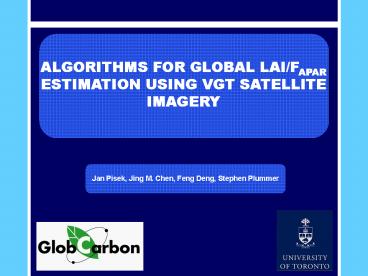Prezentace aplikace PowerPoint - PowerPoint PPT Presentation
1 / 11
Title:
Prezentace aplikace PowerPoint
Description:
ALGORITHMS FOR GLOBAL LAI/FAPAR ESTIMATION USING VGT ... AGRO, HARV, KONZ, NOBS ... NOBS, 2003. b. Specifics of the algorithm - BRDF effects are ... – PowerPoint PPT presentation
Number of Views:33
Avg rating:3.0/5.0
Title: Prezentace aplikace PowerPoint
1
ALGORITHMS FOR GLOBAL LAI/FAPAR ESTIMATION USING
VGT SATELLITE IMAGERY
Jan Pisek, Jing M. Chen, Feng Deng, Stephen
Plummer
2
Spatial and temporal resolution of the product
- global coverage in 1 km spatial resolution
- global maps produced with a time-step of 10
days
3
Global LAI product
4
d. Direct validation A Canada
- 7 validation sites
- Pisek et al. 2006, CJRS, in review
5
d. Direct validation A Canada
- 7 validation sites
Victoria 4km x 4km LAI
Ottawa 4km x 4km LAI
Kanaskasis 4km x 4km LAI
Radisson 4km x 4km LAI
TM data 1998 VGT/MODIS LAI2003
6
d. Direct validation B BigFoot sites
- used 4 sites AGRO, HARV, KONZ, NOBS
- BigFoot TM scenes (http//www.fsl.orst.edu/larse/
bigfoot/)
- MODIS ASCII subsets (http//www.modis.ornl.gov/mo
dis/index.cfm)
7
b. Specifics of the algorithm
- BRDF effects are incorporated into LAI
algorithms
- LAI algorithms are developed separately for
- several structurally distinct land cover types
- spectral indices related to the effective LAI
- all living organisms included in LAI before
sound background values can be acquired
- both SR-based algorithms and the RSR-based
- algorithms are being used
- algorithms were developed using Landsat ETM
- spectral bands
8
c. Missing data / data quality
- downloaded VGT data already atmospherically
corrected by the Simplified Method for
Atmospheric Correction (SMAC) (Rahman and
Didieu, 1994)
- we further apply a procedure called Locally
Adjusted Cubic-spline Capping (LACC) (Chen et
al., 2006, IEEE)
9
c. Missing data / data quality LACC smoothing
(Chen et al., 2006, IEEE)
10
f. Multi-sensor fusion and synergy
converting effective LAI to LAI
11
g. Future product
- development of global fields of clumping index
and background reflectances using MISR and
POLDER sensor data
- algorithms overview Deng et al., IEEE, 2006
- validation over Canada Pisek et al., CJRS,
- in review
- validation over BigFoot sites Pisek Chen,
- Missoula poster































